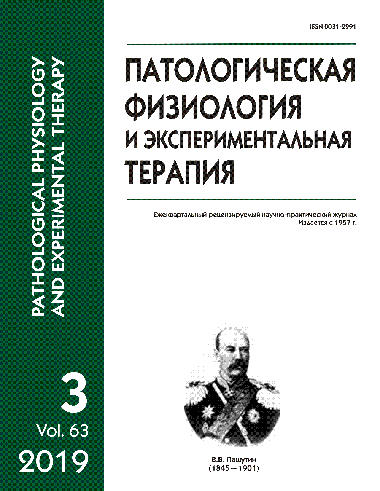The effect of local changes in ionic and enzymatic homeostasis induced by polycaprolactone scaffolds mineralized with vaterite on bone tissue regeneration
Abstract
Aim. To study the effect of local changes in enzymatic and ionic homeostasis induced by vaterite-mineralized polycaprolactone scaffolds with adsorbed alkaline phosphatase on bone tissue regeneration. The experiment was conducted on 47 mongrel male rats divided into four experimental groups: control (intact animals), comparison group (sham-operated rats), negative control (rats implanted with a matrix with adsorbed native ovabumin), and experimental group (rats implanted with PLC-CaCO3-scaffold with adsorbed alkaline phosphatase into the femoral bone defect). Alkaline phosphatase and osteocalcin contents were measured in blood of all animals on days 7 and 28. Osteocalcin was measured using the immune enzyme assay with an Immunodiagnostic Systems (France) kit and semi-automatic immune Anthos Reader 2020 (Biochrom, Great Britain) enzyme analyzer. Changes in serum alkaline phosphatase activity were detected using the kinetic method with a Sapphire-400 biochemical analyzer (Hirose Electronic Systems, Japan) and a DiaC (Russia) kit. Osteogenesis processes were verified morphologically on day 28 of the experiment by a histological assay. Transversal sections of the femoral diaphysis were examined with an AxioImager Z2 (Carl Zeiss, Germany) microscope and a µVizo-103 transmitted-light microvisor (OOO LOMO FOTONIKA, Russia). The evaluated indexes included matrix integration with saw-cut edges; bone changes in the area of matrix implantation; predominating type of matrix cell elements and the presence there of bone trabecula and blood vessels. Results. Changes in the local ionic homeostasis and homeostatic changes of alkaline phosphatase induced formation of bone trabecula in the matrix implanted into the defect area and biochemical changes in blood evident as upregulation of serum alkaline phosphatase associated with increased osteocalcin. Conclusion. In implantation of PLC-CaCO3 matrices with alkaline phosphatase, local changes in the enzymatic and ionic homeostasis induced by supplementation of calcium-containing scaffolds with alkaline phosphatase considerably stimulate osteogenesis. The biocompatibility and osteoinductive properties of PLC-CaCO3 matrices with alkaline phosphatase suggested that clinical testing of the use of the matrices for stimulation of bone tissue regeneration would be promising.






